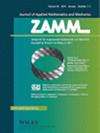Thermal characteristics for the flow of Williamson hybrid nanofluid with distinct shape factors
IF 3.2
4区 工程技术
Q1 MATHEMATICS, APPLIED
Zamm-zeitschrift Fur Angewandte Mathematik Und Mechanik
Pub Date : 2023-09-20
DOI:10.1002/zamm.202200311
引用次数: 0
Abstract
Abstract The main purpose of the present article is to investigate the flow of 2‐D, incompressible, steady, hydro magnetic Williamson hybrid nanofluid with three distinct shape factors namely spherical, cylindrical, and platelet shapes under the influence of thermal radiation and viscous dissipation effects on the flow. The aim of the current work is to investigate the thermal conduction capacity of three different shaped nanoparticles by comparison. We have modelled copper and molybdenum disulfide nanoparticles suspension in Williamson fluid blood as a conventional real fluid passing through a horizontal stretching cylinder in this case. A set of non‐linear PDEs are used to conceivably formulate the problem's physical model. The transformation from these modelled PDEs to ODEs is accomplished through the use of appropriate similarity variables. To address the problem, the RK method of order four is used in conjunction with shooting system in order to get first order ordinary equations from non‐linear higher order ordinary differential equations. To run the code for numerical results, computational Matlab bvp4c solver is used and graphs are depicted to explain the impact of various embedded physical quantities on the momentum and energy profiles accompanying the rates of shear stress and heat transfer for the considered Williamson hybrid nanofluid. The use of spherical shaped nanoparticles is thought to improve the thermal conductivity rate of the flowing fluid more than cylinder and platelet shaped nanoparticles. The skin friction coefficient is enhancing for larger values of magnetic parameter and curvature parameter but Weissenberg number has a negative trend. The rate of cooling is high for greater values of magnetic parameter, Williamson fluid parameter, heat generation parameter, thermal conduction parameter, viscous dissipation parameter and thermal radiation parameter.具有不同形状因子的Williamson混合纳米流体流动的热特性
摘要本文的主要目的是研究具有三种不同形状因子(球形、圆柱形和血小板形)的2维不可压缩、稳态、水磁Williamson混合纳米流体在热辐射和粘滞耗散效应下的流动。本文的目的是通过比较研究三种不同形状的纳米颗粒的热传导能力。在这种情况下,我们模拟了Williamson流体血液中的铜和二硫化钼纳米颗粒悬浮液,就像传统的真实流体通过水平拉伸圆柱体一样。一组非线性偏微分方程被用来令人信服地表述问题的物理模型。从这些建模的偏微分方程到偏微分方程的转换是通过使用适当的相似性变量来完成的。为了解决这个问题,将四阶RK方法与射击系统相结合,从非线性高阶常微分方程中得到一阶常方程。为了运行数值结果的代码,使用了计算Matlab bvp4c求解器,并绘制了图表来解释各种嵌入物理量对所考虑的Williamson混合纳米流体的剪切应力和传热速率伴随的动量和能量分布的影响。球形纳米颗粒的使用被认为比圆柱形和血小板状纳米颗粒更能提高流动流体的导热率。随着磁参数和曲率参数的增大,表面摩擦系数增大,但Weissenberg数呈负趋势。磁参数、Williamson流体参数、产热参数、热传导参数、粘性耗散参数和热辐射参数值越大,冷却速率越高。
本文章由计算机程序翻译,如有差异,请以英文原文为准。
求助全文
约1分钟内获得全文
求助全文
来源期刊
CiteScore
3.30
自引率
8.70%
发文量
199
审稿时长
3.0 months
期刊介绍:
ZAMM is one of the oldest journals in the field of applied mathematics and mechanics and is read by scientists all over the world. The aim and scope of ZAMM is the publication of new results and review articles and information on applied mathematics (mainly numerical mathematics and various applications of analysis, in particular numerical aspects of differential and integral equations), on the entire field of theoretical and applied mechanics (solid mechanics, fluid mechanics, thermodynamics). ZAMM is also open to essential contributions on mathematics in industrial applications.

 求助内容:
求助内容: 应助结果提醒方式:
应助结果提醒方式:


